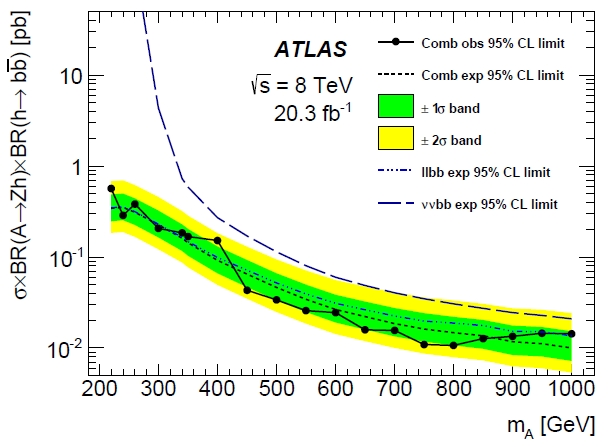If you recall what you cannot possibly have missed two years ago, when the Higgs boson discovery was announced by CERN and everybody for a while explained what that particle was about, why it had been predicted fifty years earlier, etcetera, the Higgs boson is a particle really needed by the theoretical construction we call Standard Model: only if that particle is around can we explain some of the things we observe in the subnuclear world, and only if it has a very well-defined set of specific properties can we use the Standard Model to calculate quantities that can then compare with experimental determinations. As theory and experiment are matching perfectly, particle physicists did not really doubt of the existence of the Higgs boson, and when it was finally found it was a relief rather than a true surprise.
But things might be more complex. The A boson is a hypothetical particle which could exist if the world were just a bit more complicated than we supposed it is. The regular Higgs boson arises in the theory if we make a very simple, "minimal" modification to the equation governing the dynamics of subatomic matter particles: we add a "doublet of complex scalar fields" to it - four numbers in a column of two elements. In contrast, the A particle is one of the five physical states arising in the Higgs boson sector if you admit to add to the Standard Model Lagrangian density two doublets of complex scalar fields instead than just one.
Why should we be such perverts ? I.e., if the theory works fine with fewer parameters, why adding more ? Well: the answer is the same as that given by Clinton when he was asked why he seduced an intern... Because we could. We could imagine that the Standard Model is just a little bit more complex, and see what it would happen. For sure, in the context of Supersymmetry, we would have to insert two complex doublets; and we know that Supersymmetry has several appealing features as an extension of the Standard Model... But 2HDM theories are not just SUSY; yet it makes sense to investigate this possible extension, as we really have no clue nowadays of what lies beyond.
Anyway, nowdays we know that there is at least one Higgs: the particle discovered at 125 GeV by ATLAS and CMS in 2012. If this was just one in five physical states, the others -which we know must generally be heavier, lest we would have already discovered them (I am trivializing matters a bit here, but bear with me)- might be discovered in decays to the 125 GeV Higgs.
The decay A->ZH, with H being the 125 GeV boson, has been studied by ATLAS by considering two different decay modes of the Z and two different decay modes of the H. The Z has been sought in its decays to electron pairs or muon pairs (which collectively count as one: charged lepton pairs), as well as in decays to neutrino pairs; and the Higgs has been sought in the decay to b-quark pairs, which is still the most frequent one in this extension of the SM for a wide range of parameters, as well as in its decay to tau-lepton pairs.
The result of the search is negative: no excess is observed above expected backgrounds in any of the search categories. This means that ATLAS can only set an upper limit on the cross section of A boson production, and this is done as a function of the A particle's hypothetical mass. In other words, the result is that the production rate of A particles is smaller than x(m), with m the A mass and x a certain number. If the rate was larger, ATLAS would have spotted a signal.
Graphically the result can be shown as a broken line in the cross-section versus mass plane, as shown below. As usual, the yellow-and-green band shows the result that the experiment expected to be able to obtain if the particle was indeed non-existent. The actual result (black line) wiggles around without leaving the coloured band anywhere, indicating that no excess or deficit was spotted for any of the hypothesized A mass values.

More graphs are available in the paper; among them, the interesting ones for insiders are those which use the cross section limit to extract limits on the parameter space of 2DHM's. So, congratulations to the ATLAS colleagues for being the first to produce limits on this interesting decay mode of the A boson...




Comments